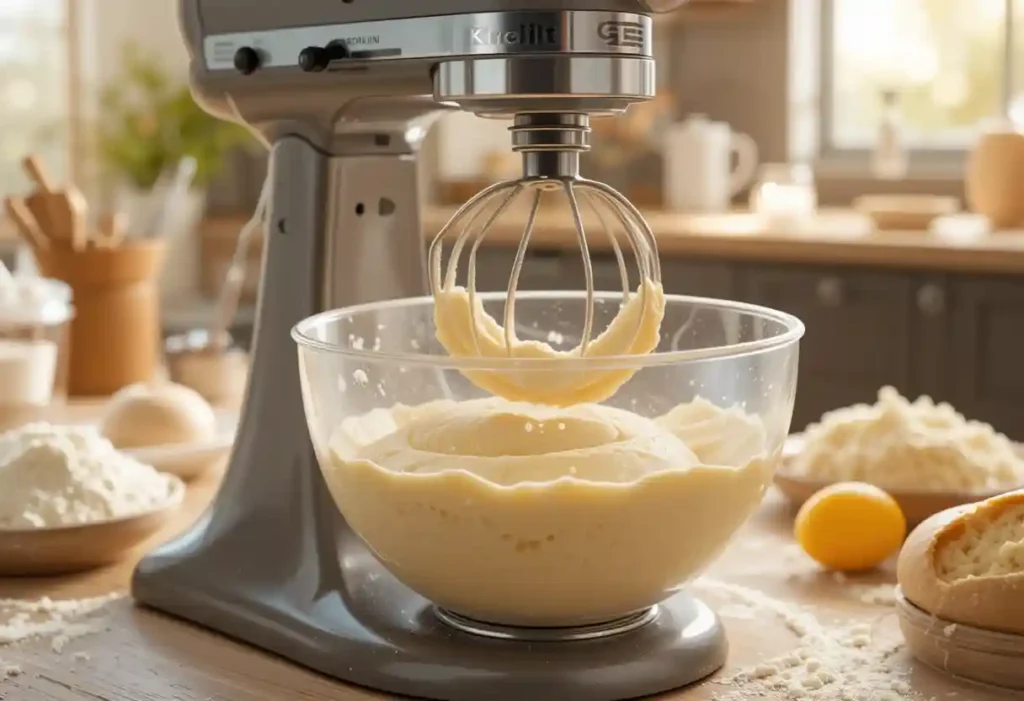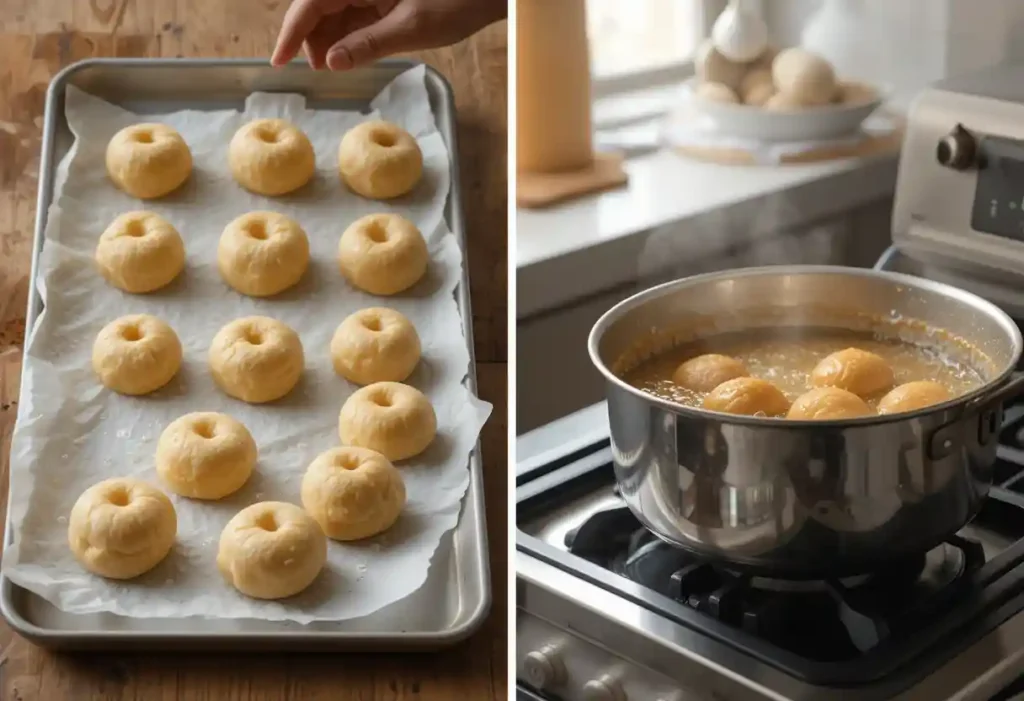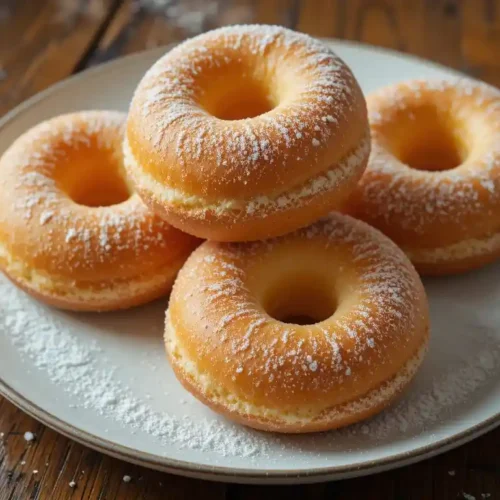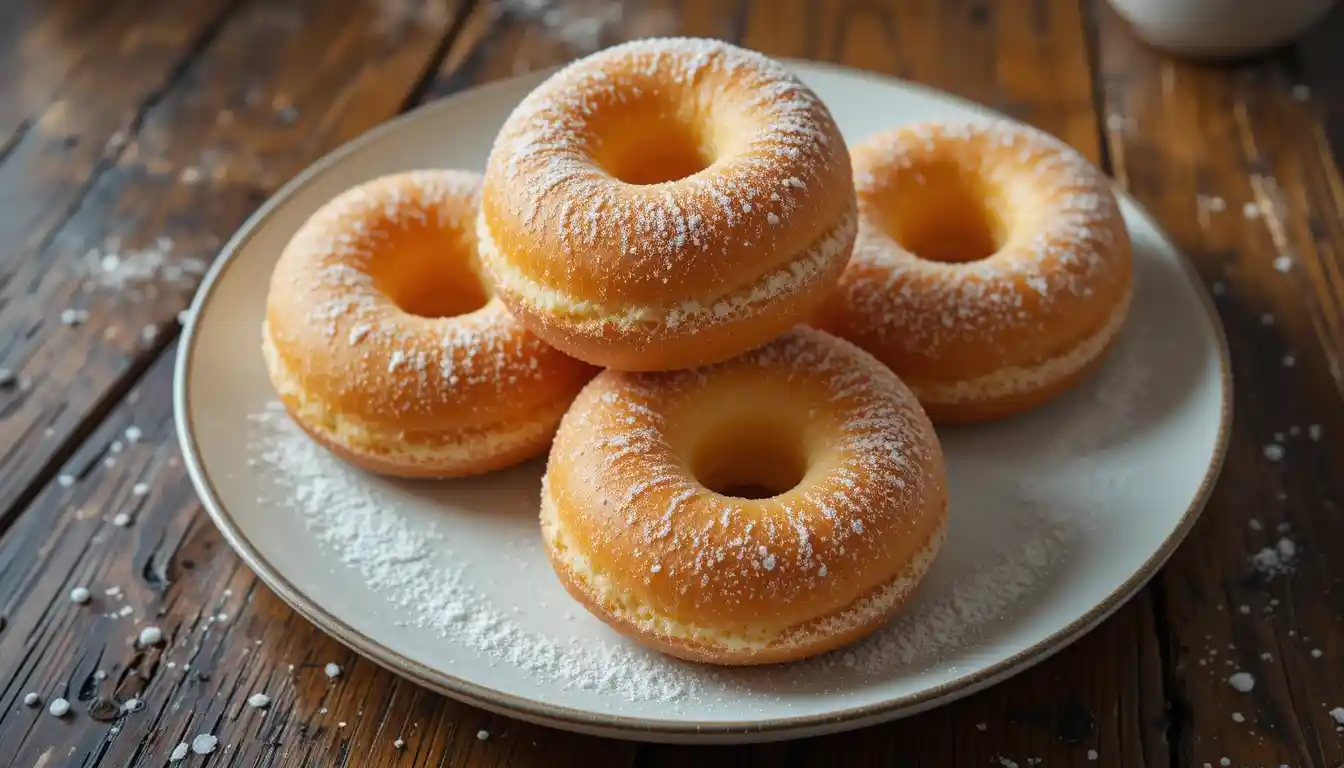Bavarian cream donut hold a special place in my heart. I love how the soft brioche dough melts in your mouth, while the smooth custard and fluffy whipped cream create a creamy surprise with every bite. If you’re like me and crave a little sweetness in the morning, the hint of vanilla sugar on top takes these donuts to the next level. This donut recipe is perfect for those moments when you want to impress friends or treat yourself to something truly special. Let’s explore how these delightful pastries come together—and why they might just become your new favorite indulgence.
What Sets Bavarian Cream Donut Apart?
Unique Characteristics
The main feature of Bavarian cream donut is the combination of a soft, airy brioche dough with a light and creamy filling. Unlike traditional cake or yeast donuts, these donuts have a tender crumb and a rich flavor. The dough is enriched with eggs and butter, which gives it a unique texture. Once fried, the donuts are tossed in vanilla sugar for a hint of extra sweetness.
Comparison with Other Donut Styles
Bavarian cream donut differ from other donuts in several ways:
- Brioche Donuts vs. Cake Donuts: Brioche donuts use a yeast-based dough that is soft and pillowy, while cake donuts have a denser, cake-like texture.
- Custard Filling vs. Jam or Cream Fillings: The custard-whipped cream blend provides a silky mouthfeel that stands apart from thicker fillings.
- Frying Techniques: Proper frying and proofing create a crisp exterior and light interior, setting these donuts apart from air fried varieties.
Essential Ingredients
Brioche Donut Dough
The success of your donuts begins with the dough. Here are the essential ingredients and tips:
- Flour: Opt for all-purpose flour to keep the recipe simple. Although bread flour may give a slightly different texture, all-purpose works well for most kitchens.
- Yeast: Instant yeast works best for this recipe. Alternatively, if you choose active dry yeast, be sure to proof it in warm water first.
- Eggs and Egg Yolks: Extra egg yolks give the dough richness and tenderness.
- Butter: Salted butter adds flavor and helps the dough become soft.
- Water: Use warm water. Water creates a lighter texture compared to milk in this recipe.
- Sugar and Salt: Sugar sweetens the dough, and salt enhances the flavor balance.
Bavarian Cream Filling
The filling is a blend of two key parts:
- Custard Base: Made from egg yolks, sugar, milk, and butter, the custard serves as the base of the filling.
- Whipped Cream: Lightly whipped heavy cream, optionally with a touch of powdered sugar, is folded into the custard. This makes the filling airy and smooth.
Ingredient Substitutions
- Dairy-Free Options: You can use plant-based milk (such as almond or oat milk) and vegan butter. For the whipped cream, look for a plant-based alternative.
- Gluten-Free Options: Substitute the all-purpose flour with a high-quality gluten-free flour blend. Keep in mind that gluten-free dough may require slight adjustments in liquid.
- Flavor Upgrades: Use real vanilla extract or vanilla bean paste for an extra burst of flavor in both the dough and the filling.
Step-by-Step Recipe: From Dough to Donut
This is the heart of the article. Follow these detailed instructions to create the perfect Bavarian cream donut.
Preparing the Dough

- Mix the Dry Ingredients:
- In a large bowl, combine 4 1/2 cups (540g) of all-purpose flour, 2 1/4 teaspoons (7g) of instant yeast, 3 tablespoons (36g) of granulated sugar, and 1 teaspoon of salt.
- Stir the dry ingredients to ensure even distribution.
- Add the Wet Ingredients:
- In another bowl, beat 2 large eggs and 2 large egg yolks.
- Add the eggs to the flour mixture along with 1/2 cup (113g) of softened salted butter.
- Pour in 1 cup (8oz) of warm water. The water should feel warm to the touch, around 100°F (38°C).
- Mix and Knead:
- Use a stand mixer fitted with a dough hook attachment on low speed.
- Mix until the ingredients form a rough dough. Increase the speed to medium-low.
- Knead the dough for 10 to 15 minutes. You should see the dough pull away from the bowl and become smooth and elastic.
- Proof the Dough:
- Place the dough into a bowl that has been lightly coated with oil.
- Cover it with a fresh dish towel or a layer of plastic wrap.
- Allow the dough to proof in a warm spot (75°F to 100°F) for 1–2 hours until it doubles in size.
Shaping and Frying

- Shape the Dough:
- After the dough has risen, gently press it down to release the air.
- Turn the dough onto a floured surface.
- Split the dough into two equal portions and shape each into a long log.
- Cut the logs into equal pieces (about 16 pieces total, or adjust based on your desired donut size).
- Form the Donut Shapes:
- Shape each portion into a compact, smooth sphere.
- Arrange the balls on a baking sheet that’s been lined with parchment paper.
- Cover the balls with a cloth and let them proof for 30 to 60 minutes until they puff up slightly.
- Prepare for Frying:
- In a deep pot or heavy skillet, heat vegetable, sunflower, or canola oil. Ensure there’s sufficient oil to completely immerse the donuts.
- The oil should reach 360°F (182°C). A candy thermometer works best to monitor the temperature.
- Frying the Donuts:
- Carefully place a few donuts into the oil. Do not overcrowd the pot.
- Fry each side for 1 to 2 minutes until the donuts turn golden brown. Look for a slight white ring around the center.
- Use a slotted spoon to remove the donuts and place them on cooling racks lined with paper towels.
- While still warm, toss the donuts in a mixture of granulated sugar, cinnamon, and a touch of vanilla powder.
Crafting the Bavarian Cream Filling

- Prepare the Custard:
- In a small saucepan, whisk 3 large egg yolks with 1/2 cup (100g) of granulated sugar and a pinch (1/8 teaspoon) of salt.
- Slowly add 3/4 cup (180mL) of whole milk while whisking continuously.
- Set the saucepan on medium-low heat and stir continuously until the mixture thickens, roughly 5 minutes.
- Once thickened, whisk a little more vigorously for one extra minute.
- Remove from heat and stir in 2 tablespoons (28g) of softened salted butter.
- Place a layer of plastic wrap over the mixture to prevent skin from forming. Let it cool to room temperature, then move it to the refrigerator.
- Whip the Cream:
- In a chilled bowl, add 1 1/3 cups (300mL) of heavy whipping cream and 1/4 cup (30g) of powdered sugar.
- Using a stand or hand mixer, beat the cream on medium speed until soft peaks appear.
- Switch the mixer to medium-high and beat until stiff peaks form, taking care not to overwhip so that the cream stays silky smooth.
- Combine Custard and Whipped Cream:
- Once the custard is cool, gently fold the whipped cream into the custard. Use a spatula and mix slowly to preserve the airy texture.
- The final filling should be smooth, light, and spreadable.
Assembling the Donuts

- Fill the Donuts:
- Let the donuts cool completely before filling.
- Use a piping bag with a small tip or a plastic bag with a corner snipped off.
- Insert the tip into the donut and fill with the Bavarian cream mixture. Be careful not to overfill, which might cause the filling to leak.
- Final Touches:
- Once filled, dust the donuts lightly with extra vanilla sugar or cinnamon sugar if desired.
- Serve immediately for the best taste and texture.
Pro Techniques & Troubleshooting Tips
Expert Techniques
- Proofing the Dough:
Allow the dough to rest in a warm, draft-free space until it doubles in size. If it rises slowly, consider placing it in an oven on its lowest setting or on top of a gently heated appliance. - Using a Digital Scale:
Weigh your ingredients for better accuracy. This step ensures that your dough and custard are consistent each time you bake. - Monitoring Oil Temperature:
Always use a candy thermometer to maintain the oil at 360°F (182°C). Too hot, and the donuts will brown quickly without cooking through; too cool, and they may absorb excess oil. - Folding the Filling:
Gently fold the custard into the whipped cream to keep the airy texture intact. Avoid overmixing, as it can cause the whipped cream to collapse and produce a denser filling.
Troubleshooting Common Issues
- Sticky Dough:
If the dough sticks to your hands or surface, add a small amount of flour. Be careful not to add too much, as it may change the texture of the donuts. - Over-Proofing:
If your dough doubles and then begins to collapse, it may be over-proofed. This can lead to a flat, dense donut. Keep a close watch on the rising process and follow the recommended proofing times. - Filling Separation:
If the custard and whipped cream separate, check that the custard is completely cooled before folding in the cream. Chill the custard thoroughly, then mix gently. - Uneven Frying:
Ensure your oil is evenly heated. Avoid overcrowding the pot, as too many donuts at once can drop the oil temperature and lead to uneven cooking.
Flavor Variations & Creative Enhancements
While the classic Bavarian cream donut is delightful, you can add creative twists to suit your taste:
Innovative Twists
- Chocolate Variation:
Mix in 2 tablespoons of cocoa powder with the custard to achieve a rich, chocolate-infused filling that beautifully complements the tender dough. - Nutella or Peanut Butter:
Swirl ¼ to ½ cup of Nutella or peanut butter into the finished cream for a rich, nutty flavor. - Lemon Zest:
Add the zest and juice of one lemon to the custard for a refreshing twist. The citrus flavor cuts through the richness and adds brightness.
Coating Ideas
- Cinnamon Sugar:
Instead of plain vanilla sugar, mix in ground cinnamon to dust the donuts. This adds a warm, spiced note. - Powdered Sugar Glaze:
For an extra sweet touch, dip the donuts in a glaze made from powdered sugar, a splash of milk, and vanilla extract.
Seasonal Variations
- Fall Flavor:
Mix a dash of nutmeg or pumpkin spice into the dough, then finish by drizzling caramel sauce over the donuts. - Holiday Twist:
Use festive decorations such as colored sugar or edible glitter for special occasions. This can add a cheerful touch to your presentation.
Pairing Suggestions
- Beverages:
Enjoy your donuts with a cup of coffee, tea, or hot cocoa. The pairing can enhance the overall flavor experience. - Side Treats:
Pair these donuts with a fresh fruit salad or a scoop of ice cream to create an exciting contrast in temperature and texture that elevates the overall treat.
These variations allow you to make the recipe your own. Experiment with different flavors to find your favorite version of the Bavarian cream donut.
Conclusion
By now, you’ve seen how simple it is to create your own Bavarian cream donut. We covered everything from key ingredients to foolproof techniques that ensure a perfect bite every time. Whether you’re a seasoned baker or just starting out, these light, airy donuts offer a delightful mix of flavors and textures.
For more sweet inspirations, be sure to explore our desserts category. You’ll find a variety of mouthwatering recipes to keep your baking adventures exciting.
Happy baking, and enjoy every delicious bite!

Bavarian Cream Donut
Ingredients
Brioche Donut Dough:
- 4 1/2 cups 540g all-purpose flour
- 2 1/4 tsp 7g instant yeast
- 3 Tbsp 36g granulated sugar
- 1 tsp salt
- 2 large eggs room temperature
- 2 large egg yolks room temperature
- 1/2 cup 113g salted butter, softened
- 1 cup 8oz warm water
For Coating:
- 1 cup 200g granulated sugar
- 1 tsp cinnamon and/or 1/2 tsp vanilla powder
Custard (Filling Base):
- 3 large egg yolks room temperature
- 1/2 cup 100g granulated sugar
- 1/8 tsp salt
- 3/4 cup 180mL whole milk
- 2 Tbsp 28g salted butter, softened
Whipped Cream:
- 1 1/3 cups 300mL heavy whipping cream, cold
- 1/4 cup 30g powdered sugar
Instructions
Prepare the Dough:
- In a large bowl, mix 4 1/2 cups flour, 2 1/4 tsp yeast, 3 Tbsp sugar, and 1 tsp salt.
- Add 2 large eggs, 2 large egg yolks, 1/2 cup softened butter, and 1 cup warm water.
- Using a stand mixer with a dough hook, knead for 10–15 minutes until the dough is smooth and elastic.
- Transfer to a greased bowl, cover, and let rise for 1–2 hours until doubled in size.
Shape the Dough:
- Punch down the risen dough and turn it onto a lightly floured surface.
- Divide the dough in half, roll each half into a log, and cut into equal pieces.
- Roll each piece into a tight ball and arrange them on a parchment-lined tray.
- Cover and let proof for 30–60 minutes until slightly puffed.
Fry the Donuts:
- Heat oil in a deep pot or fryer to 360°F (182°C).
- Fry the dough balls in batches for 1–2 minutes per side until golden brown.
- Remove with a slotted spoon, drain on paper towels, and immediately toss with a mix of 1 cup granulated sugar and cinnamon or vanilla powder.
Craft the Bavarian Cream Filling:
- In a saucepan, whisk 3 large egg yolks, 1/2 cup granulated sugar, and 1/8 tsp salt; slowly add 3/4 cup whole milk.
- Cook over medium-low heat for about 5 minutes until thickened, whisking continuously.
- Remove from heat, stir in 2 Tbsp softened butter, and let cool completely (chill if desired).
- In a chilled bowl, whip 1 1/3 cups heavy cream with 1/4 cup powdered sugar to stiff peaks.
- Gently fold the whipped cream into the cooled custard until smooth.
Assemble the Donuts:
- Allow the fried donuts to cool completely.
- Using a piping bag, carefully fill each donut with the Bavarian cream filling.
- Optionally, dust with extra vanilla sugar before serving.
FAQs
What makes the brioche dough special for these donuts?
The brioche dough uses extra egg yolks and butter, which makes it soft and tender. The dough undergoes a careful proofing process that creates a light, airy texture.
Can I use a different type of milk for the custard?
Yes. While whole milk offers a richer flavor, you can opt for 2% milk or a plant-based alternative, though the texture might be a bit different.
How do I know when my oil is the right temperature?
Use a candy thermometer to check that the oil reaches 360°F (182°C). The donuts should float lightly when added, and you should see a golden-brown color forming quickly.
Can I prepare the dough in advance?
Yes. You can prepare the dough and let it proof in the refrigerator overnight. This slow rise can enhance the flavor and make it easier to work with.
How long do the filled donuts stay fresh?
Filled donuts are best served on the day they are made. If you need to store them, keep them in an airtight container at room temperature for a few hours or refrigerate for 1-2 days. Bring them to room temperature before serving.

